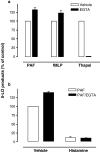Histamine-induced inhibition of leukotriene biosynthesis in human neutrophils: involvement of the H2 receptor and cAMP
- PMID: 14744809
- PMCID: PMC1574237
- DOI: 10.1038/sj.bjp.0705654
Histamine-induced inhibition of leukotriene biosynthesis in human neutrophils: involvement of the H2 receptor and cAMP
Abstract
1. Histamine is generally regarded as a pro-inflammatory mediator in diseases such as allergy and asthma. A growing number of studies, however, suggest that this autacoid is also involved in the downregulation of human polymorphonuclear leukocyte (PMN) functions and inflammatory responses through activation of the Gs-coupled histamine H(2) receptor. 2. We report here that histamine inhibits thapsigargin- and ligand (PAF and fMLP)-induced leukotriene (LT) biosynthesis in human PMN in a dose-dependent manner. 3. The suppressive effect of histamine on LT biosynthesis was abrogated by the histamine H(2) receptor antagonists cimetidine, ranitidine, and tiotidine. In contrast, the histamine H(1), H(3), and H(4) receptor antagonists used in this study were ineffective in counteracting the inhibitory effect of histamine on the biosynthesis of LT in activated human PMN. 4. The inhibition of LT biosynthesis by histamine was characterized by decreased arachidonic acid release and 5-lipoxygenase translocation to the nuclear membrane. 5. Incubation of PMN with the cAMP-dependent protein kinase (PKA) inhibitor N-[2-(p-bromocinnamylamino)ethyl]-5-isoquinoline-sulfonamide prevented the inhibitory effect of histamine on LT biosynthesis, suggesting an important role for PKA in this effect of histamine on LT biosynthesis in PMN. 6. These data provide the first evidences that, similarly to adenosine and prostaglandin E(2), histamine is a potent suppressor of LT biosynthesis, and support the concept that histamine may play a dual role in the regulation of inflammation.
Figures






Similar articles
-
Inhibition of platelet-activating factor biosynthesis by adenosine and histamine in human neutrophils: involvement of cPLA2alpha and reversal by lyso-PAF.J Leukoc Biol. 2006 May;79(5):1043-51. doi: 10.1189/jlb.1005614. Epub 2006 Feb 24. J Leukoc Biol. 2006. PMID: 16501051
-
Cyclic AMP-mediated inhibition of 5-lipoxygenase translocation and leukotriene biosynthesis in human neutrophils.Mol Pharmacol. 2002 Aug;62(2):250-6. doi: 10.1124/mol.62.2.250. Mol Pharmacol. 2002. PMID: 12130675
-
Activation of leukotriene synthesis in human neutrophils by exogenous arachidonic acid: inhibition by adenosine A(2a) receptor agonists and crucial role of autocrine activation by leukotriene B(4).Mol Pharmacol. 1999 Nov;56(5):1055-62. doi: 10.1124/mol.56.5.1055. Mol Pharmacol. 1999. PMID: 10531413
-
Adenosine. An endogenous inhibitor of arachidonic acid release and leukotriene biosynthesis in human neutrophils.Adv Exp Med Biol. 1999;447:107-15. Adv Exp Med Biol. 1999. PMID: 10086187 Review.
-
Adenosine, a potent natural suppressor of arachidonic acid release and leukotriene biosynthesis in human neutrophils.Am J Respir Crit Care Med. 2000 Feb;161(2 Pt 2):S88-94. doi: 10.1164/ajrccm.161.supplement_1.ltta-18. Am J Respir Crit Care Med. 2000. PMID: 10673234 Review. No abstract available.
Cited by
-
COVID-19: Famotidine, Histamine, Mast Cells, and Mechanisms.Res Sq [Preprint]. 2020 Aug 31:rs.3.rs-30934. doi: 10.21203/rs.3.rs-30934/v3. Res Sq. 2020. Update in: Front Pharmacol. 2021 Mar 23;12:633680. doi: 10.3389/fphar.2021.633680. PMID: 32702719 Free PMC article. Updated. Preprint.
-
Histidine decarboxylase inhibition attenuates cancer-associated muscle wasting.J Exp Med. 2025 Sep 1;222(9):e20242239. doi: 10.1084/jem.20242239. Epub 2025 Jul 2. J Exp Med. 2025. PMID: 40600951
-
High levels of eicosanoids and docosanoids in the lungs of intubated COVID-19 patients.FASEB J. 2021 Jun;35(6):e21666. doi: 10.1096/fj.202100540R. FASEB J. 2021. PMID: 34033145 Free PMC article. Clinical Trial.
-
Potentiation of NF-kappaB-dependent transcription and inflammatory mediator release by histamine in human airway epithelial cells.Br J Pharmacol. 2007 Nov;152(6):891-902. doi: 10.1038/sj.bjp.0707457. Epub 2007 Sep 24. Br J Pharmacol. 2007. PMID: 17891168 Free PMC article.
-
Role of Histamine in Modulating the Immune Response and Inflammation.Mediators Inflamm. 2018 Aug 27;2018:9524075. doi: 10.1155/2018/9524075. eCollection 2018. Mediators Inflamm. 2018. PMID: 30224900 Free PMC article. Review.
References
-
- AMSELLEM C., CZARLEWSKI W., LAGARDE M., PACHECO Y. Inhibitory effect of loratadine on leukotriene B4 production by neutrophils either alone or during interaction with human airway epithelial cells. Pulmon. Pharmacol. Ther. 1998;11:245–252. - PubMed
-
- BAROODY F.M., NACLERIO R.M. Antiallergic effects of H1-receptor antagonists. Allergy. 2000;55:17–27. - PubMed
-
- BONVENTRE J.V., HUANG Z., TAHERI M.R., O'LEARY E., LI E., MOSKOWITZ M.A., SAPIRSTEIN A. Reduced fertility and postischaemic brain injury in mice deficient in cytosolic phospholipase A2. Nature. 1997;390:622–625. - PubMed
-
- BORGEAT P., PICARD S., DALLAIRE N., POULIOT M., SURETTE M.E.Quantitative studies of the lipid mediators of inflammation using liquid chromatography-electrospray mass spectrometry Molecular and Cellular Basis of Inflammation 1998Totowa, NJ: Humana Press Inc; 275–288.ed. Serhan C.N. & Ward, P.A. pp
-
- BORGEAT P., PICARD S., VALLERAND P., BOURGOIN S., ODEIMAT A., SIROIS P., POUBELLE P.E. Automated on-line extraction and profiling of lipoxygenase products of arachidonic acid by high-performance liquid chromatography. Methods Enzymol. 1990;187:98–116. - PubMed
Publication types
MeSH terms
Substances
Grants and funding
LinkOut - more resources
Full Text Sources

